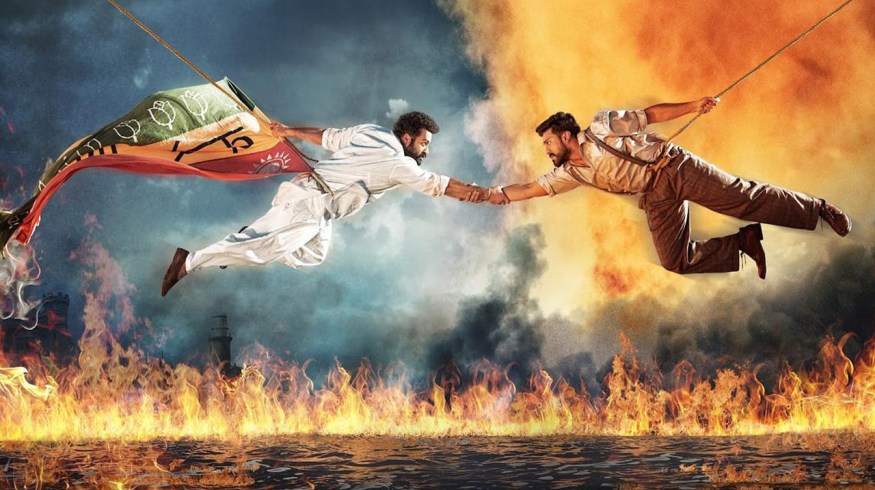
RRR and Everything You Need to Know About Tollywood Cinema
Let’s take a look into how RRR is putting Tollywood cinema on the world map—in the most epic and unforgettable way possible.
If you’ve been on the Film Twitter™ in the last few weeks, you might have noticed several awesome GIFs of handsome Indian men dancing with their suspenders or perhaps yelling-fighting with a tiger. Yet, unless you’ve been keeping up with the international film trade papers, you might not have heard about the latest film sensation from India.
We’re talking, of course, about the absolutely incredible and insane Indian Telugu-language epic action drama film RRR, which was the most expensive Indian film ever made and has pushed Bollywood (and more specifically, the Telugu-language “Tollywood” film industry) into the mainstream.
So, whether you’ve experienced the visceral cinematic experience that is RRR in theaters or on Netflix, or RRR has just come onto your radar, let’s take a look at this film, what makes it so unique, and catch you up on everything you need to know about Tollywood cinema and how it could continue to shape the future international film landscape.
The Story of RRR
Ok, so let’s briefly try to summarize the story of RRR. And I say briefly because the film comes in at 182 minutes (just over three hours) and contains A LOT of stuff. (And when I say “stuff,” I mean everything from insane fight scenes, action sequences, dance numbers, and high-stakes drama.) But at its core, RRR is a story about revolution.
Set in the 1920s, RRR follows the story of two real-life revolutionaries in India—Alluri Sitarama Raju (played by Ram Charan) and Komaram Bheem (played by N. T. Rama Rao Jr.)—and their fight against the British Raj who ruled their country at the time. In a story that might be familiar to American audiences from similar films like The Departed or Gangs of New York, the plot follows these two revolutionaries on both sides of the law before they ultimately choose to join forces to fight for their country.
The History of Bollywood
To be honest, we should probably backtrack a little bit to catch up on the history of Bollywood cinema for anyone who might not be familiar.
Bollywood is the nickname for Indian Hindi-language cinema based around Mumbai. Bollywood is an off-shoot of its previous nickname of Bombay cinema, as Mumbai used to be called Bombay until its name changed to Mumbai in 1995. Mumbai is referred to as the de-facto center of India and has served as the hub for Indian cinema for several decades.
From the first Indian musical talkie Alam Ara in 1931, Bollywood has closely followed Hollywood cinema in terms of style, scope, and success. This robust economy of film at times rivals—if not outright exceeds—Western mainstream cinema. (For example, after 2001 ticket sales, Indian cinema—including Hindi films—reportedly numbered 3.6 billion sales, dwarfing Hollywood’s 2.6 million sales.)
However, as with American and Western cinema, even within Bollywood, there are sharp distinctions and plenty of nuances between locales, filmmakers, and genres.
As mentioned above, Bollywood serves as a catch-all term for all Indian Hindi films. However, as of 2014, Hindi cinema only represents about 40% of the Indian box office, whereas Tamil and Telugu cinema (aka Tollywood) represent roughly 30% each as well.
Tollywood and Other Off-shoots
As we established at the start, RRR is the new grand achievement of Tollywood cinema. While this ingustry is connected to Bollywood, it also has its own unique style and flavor—all of which is perfectly on display in RRR‘s grandiose action scenes and fantastical musical numbers.
Telugu cinema (aka Tollywood) is a segment of Indian cinema created in the states of Telangana and Andhra Pradesh, which both speak the Telugu language. Tollywood’s home is Film Nagar—also known as Tinsel Town or Tollywood—which is a neighborhood in the western part of Hyderabad, Telangana, India.
Its rise within Indian cinema has quickly rivaled the most significant excesses of classic Bollywood cinema. It has become a major world player with the breakout success of films like RRR, Baahubali: The Beginning, and Baahubali 2: The Conclusion.
Along with Tollywood, there is also Tamil cinema (aka Kollywood) based on the Tamil language found in Chennai, Tamil Nadu, in the Kodambakkam neighborhood. Some notable films over the years include the silent-era film Keechaka Vadham in 1918 and Kalidas (1931), which came out a few months after India’s first talking picture.
The Filmmakers of RRR
Now, back to RRR. Decorated filmmaker S. S. Rajamouli directed and wrote the film with V. Vijayendra Prasad while being produced by D. V. V. Danayya—all three power players in modern Tollywood Telugu cinema.
And if RRR is one’s first foray into Tollywood cinema, it might be the perfect example of modern Tollywood’s beautiful mix of ambition, action, and heartfelt storytelling, which has helped blockbusters like RRR break through from Telugu audiences to the world stage.
Classified as an epic action drama film, RRR splits modern genre theory apart as it never lets itself get bogged down into one distinct genre style. RRR first began production in 2018 and was shot extensively across India up until — and through—the COVID-19 pandemic and lockdowns.
The film is also notable for its astute use of CGI and motion graphics that are stylistically blended into the action and cinematography by K. K. Senthil Kumar. Its CGI is on part with what you might see in a modern Marvel film, yet with a distinct flair that lends itself to the more fantastic rather than mundane.
As many online have pointed out and enjoyed, RRR is also a musical of sorts as the soundtrack to the film (composed by M. M. Keeravani) serves both as narrative voice-over as well as a classic Bollywood musical sing-along style at times.
The overall effect, though, is a film that builds kinetic energy early with its high drama and action yet keeps getting bigger as it goes with epic action sets, sweeping dance numbers, and some “ultimate showdowns” at the end.
The Future of Tollywood and International Cinema
All told, if you haven’t seen RRR yet, you absolutely should watch it ASAP. It’s a rare opportunity to see not only a foreign language film and a glimpse into another part of international cinema but also perhaps a glimpse into the future of world cinema. All of which is incredible valuable for a filmmaker.
As the internet continues to connect audiences and filmmakers from across the globe, any ideas of narrowly regionally defined creators are on the way out. Future filmmakers—very much like the filmmakers of RRR—are becoming much more versed in the cinema stylings of the rest of the world as we all collectively work to make films that can resonate with audiences anywhere.
RRR might be one of the latest—but certainly not the last—film that feels bigger than its filmmakers, audience, or region. The film offers a spotlight back onto its roots yet is still reflective of a greater future for filmmakers everywhere.
Feature image via DVV Entertainment
For more filmmaking trends, insights and discussions, check out these articles below:





